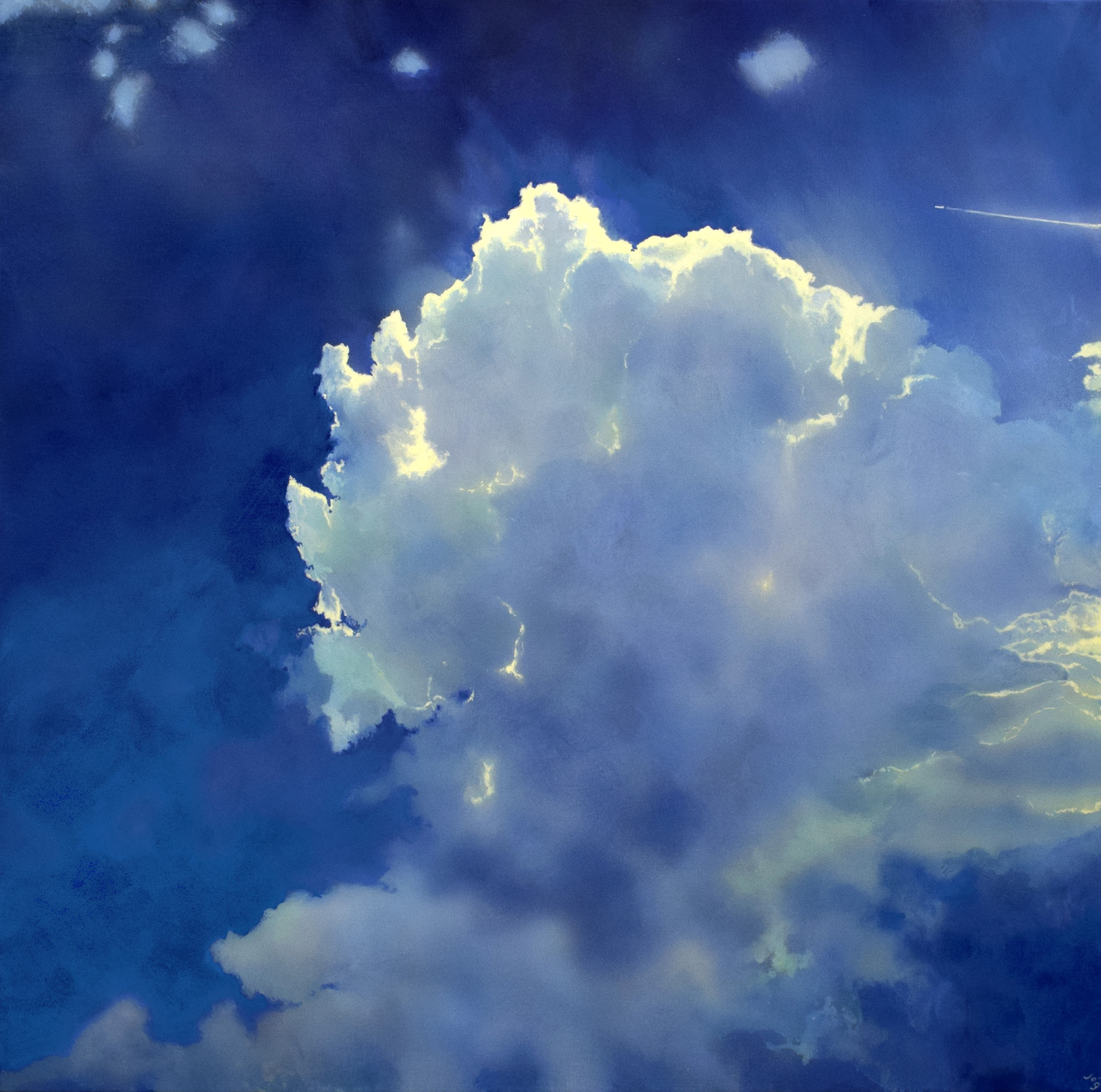
Icarus IV, ©John O’Grady (click on the image to enlarge)
31.75″ x 31.75″ x 1.75″ acrylic on deep edge canvas, ready to hang
$2190 (approx. €1950, £1742) with free shipping.
The journey a painting takes is often one of a winding path with culs-de-sac and odd moments of freewheeling breakthroughs.
You may find it interesting to discover a visual diary of this journey.
I hope you enjoy it.
Stage 1
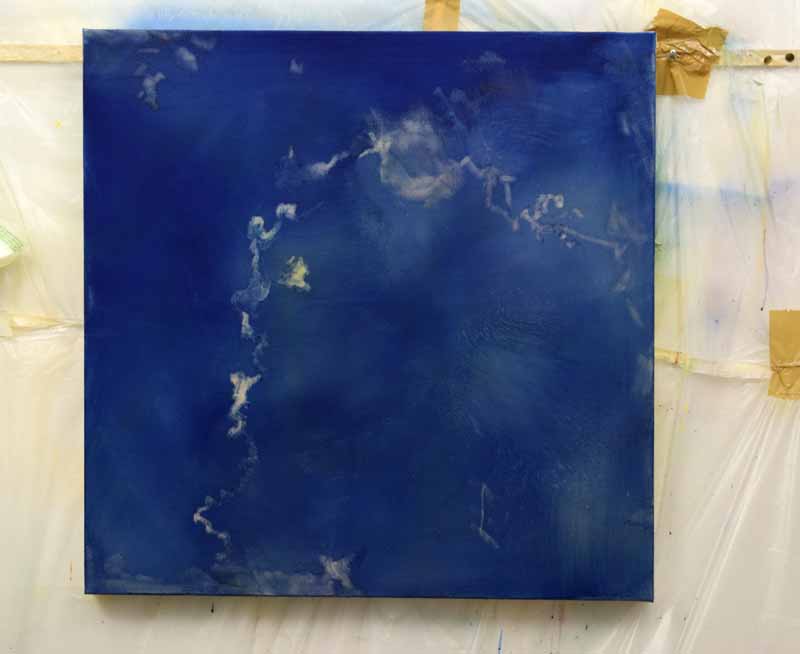
With a large flat brush. I wet the blank canvas and then ran on each side, along the edge a line of colour: Egyptian violet, Prussian blue, cerulean blue and Paynes grey.
Using the large brush and starting from the top, I made horizontal strokes across the canvas.
Next, I turned it 90 degrees and repeated the action.
Result: a movement of midnight blue on the left and lightish blue to the right you might be able to see in the painting.
While the paint was still wet, I wrapped a wet cloth around my index finger and lifted out shapes of light, some with hard edges and some with soft.
When I took the first photo, the form highlighted reminded me of a map of France.
Stage 2
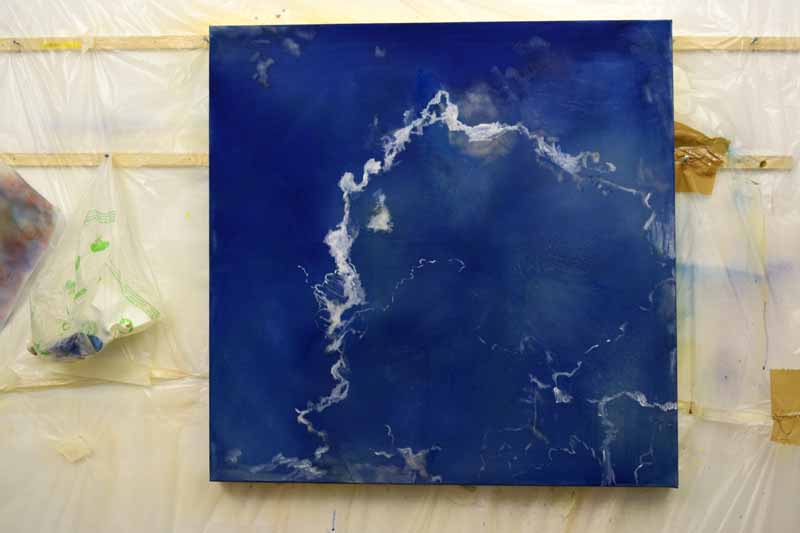
After the painting had dried, I took a smallish brush loaded with a light blue-white and very quickly and intuitively made lots and lots of quick marks, rounded in form, building up these squiggly lines into cloud-like shapes.
I had in mind to make a new Icarus painting though here, it’s larger in scale.
When I had finished this stage, I felt like energy and a diaphanous quality was beginning to appear. I was feeling quite good about my map of France cloudscape.
Stage 3
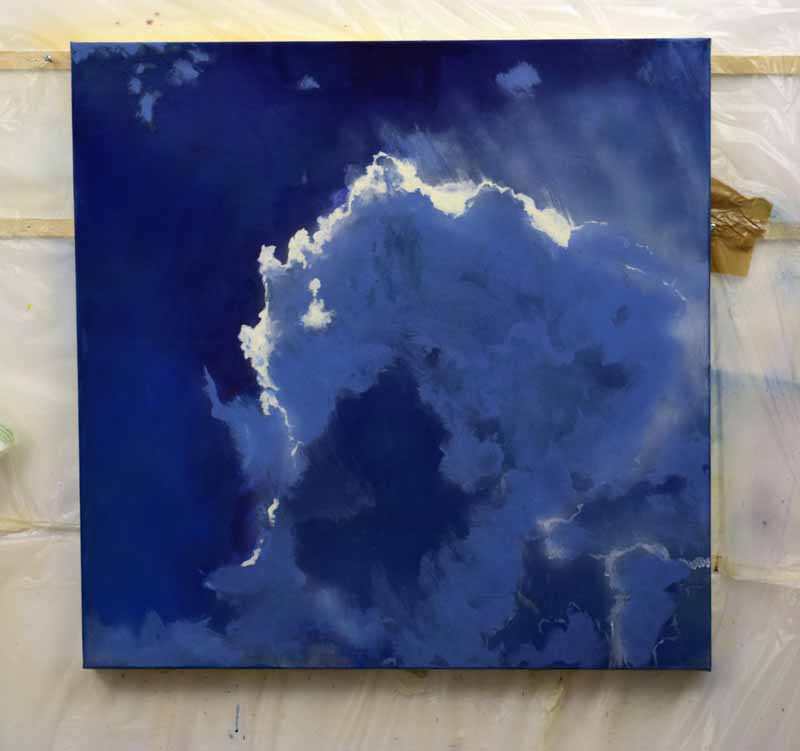
The following day, I needed to build up the contrast in negative and positive space between cloud and sky.
With Paynes grey and pthalo blue lightened with titanium white, I worked in with a large brush.
I find at this stage blocking in with a large brush gives an energy to the piece and avoids getting too fiddly too early.
Once the cloud shape was blocked in, I roughly filled in a back-lit light to surround the cloud with yellow medium azo and titanium white.
It was time to take stock.
I liked the way the shape had movement as if it was slowly tipping to the right.
I liked the shape of the leg jutting out into the midnight blue sky. It also acted as a counterbalance to the large mass tipping to the right.
I felt the blue worked in the cloud and to some extent so did the filigree.
The cloud however was too heavy and dense and the dark blue shape in the centre didn’t work for me.
Let’s see what stage 4 brought.
Stage 4
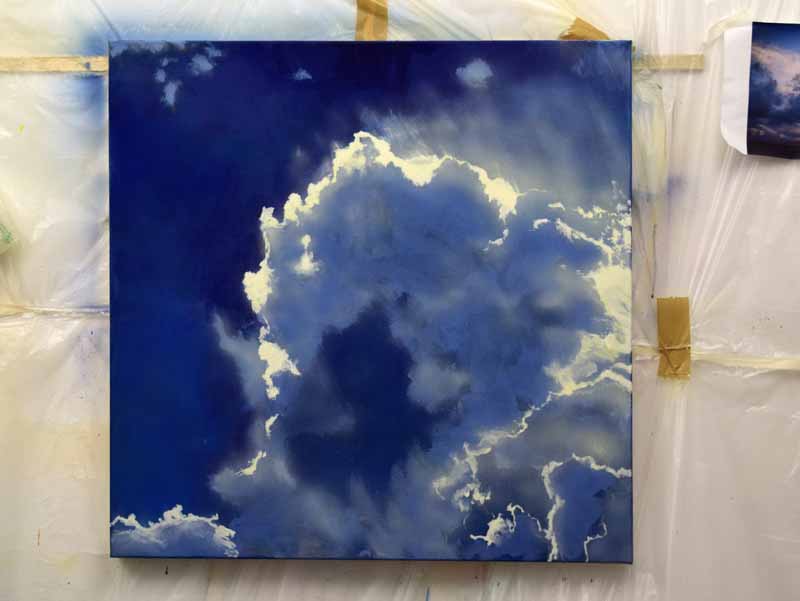
Today was about trying to inject some lightness and light into the heaviness of the shape.
I added top right some vaporous diagonal movement as if taken by the wind and worked on the light around the cloud.
To create interest, different shapes with hard and soft edges help keep the eye moving around the painting.
Then, to bring light into the main body of the cloud, I applied a glaze of very pale yellow followed by a pale blue.
At the end of the day, my feelings were one of resignation. ‘Oh no, here it goes again, I’m entering the difficult getting stuck middle phase so many paintings go through.’
The battle began.
Before leaving the studio that night, I remembered Hemingway’s wise words from his book ‘Moveable Feast’. He finished a day’s writing by leaving a sentence or paragraph half finished, so he knew he had a way back into the work the following day. (Please see below)
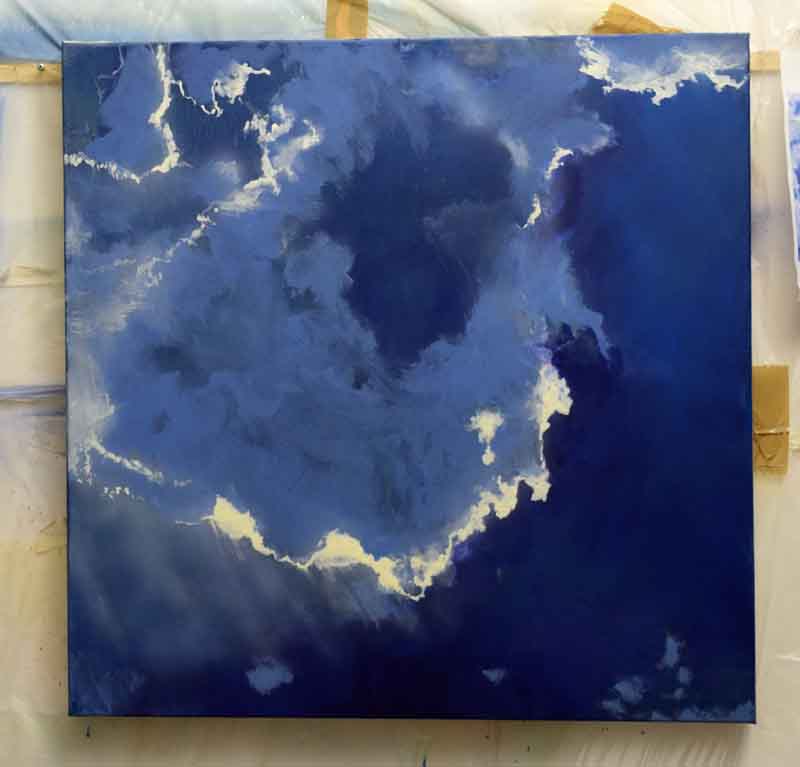
I turned the painting upside down and found the negative space had reversed and the cloud had now become the sky and vice versa.
Quite excited at the energy in the shapes, particularly the cloud rising into the sky top left, I started to work on the filigree just a little and then stopped, knowing I had, à la Hemingway, a way into the painting the following day.
Stage 5
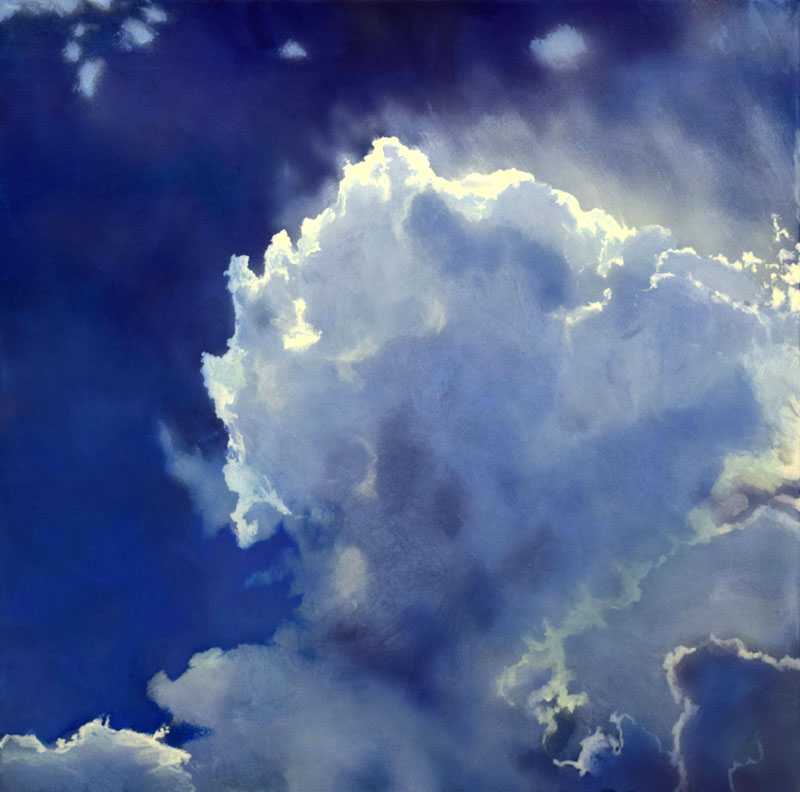
My upside down painting didn’t thrill me at all but as promised the night before, I carried on working on the filigree around the cloud.
When completed, I turned the work back around again.
That looked much better.
In retrospect, this stage was the day when the painting took on some freewheeling momentum and it began to finish itself.
After adding shapes in the cloud with glazes of light and dark, I started to notice transparent qualities and movement.
Stage 6
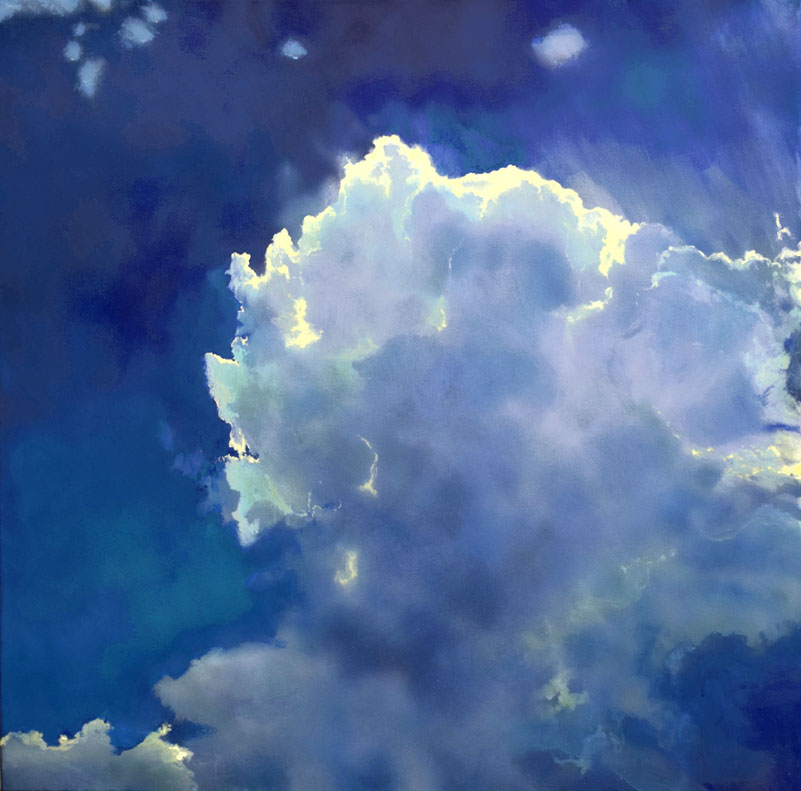
The shapes had pretty much taken hold.
They felt balanced and harmonious but I wasn’t happy with the overall blueness of the cloud next to the sky.
Colour is light.
I needed that increased range of colour to give it that mutable quality.
Glazes of rose and teal were added into and over the blue, shifting the colours slightly.
Areas of light broke through the cloud again breaking up the overall shape.
Blue green was added into the sky bottom left to anchor the painting.
The cloud was now glowing.
To come full circle, the finished piece
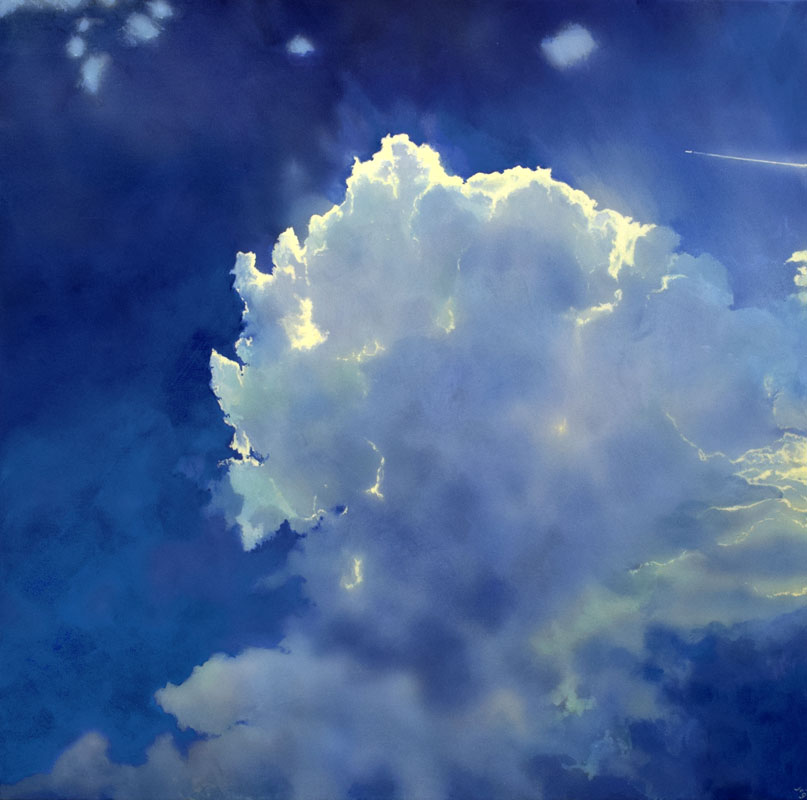
I added more warmth with a light golden yellow over the rose and teal in parts. This created the perfect counterpoint to the deep dark blueness of the sky.
Last of course, I placed my tiny craft in the sky, dwarfed by the immensity of nature.
I tried to place it three times in various parts of the painting and eventually found the most pleasing place.
And to give you an idea of the painting’s size:
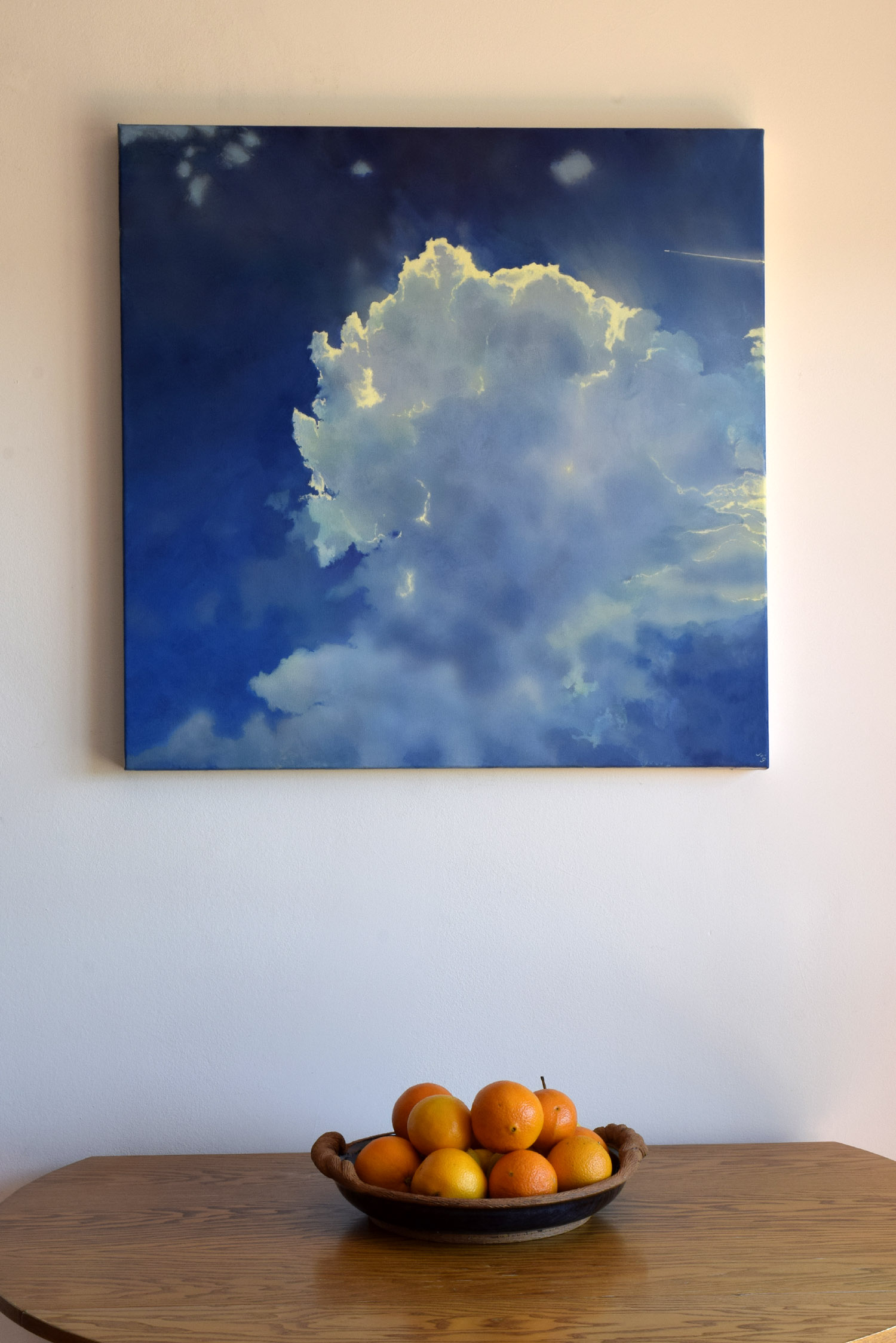
I’d love to hear what you think of this journey of a painting. Do let me know.
Fascinating insight into your creative process.
Thanks very much Robert, glad to hear you found it rewarding
Hello John, this is absolutely fascinating – so interesting to have a commentary on the creation of such a wonderful painting. I imagine it must have been hard to stop and think about each stage in this way as perhaps you might ordinarily follow your instinctive talent without necessarily recording it. The end result is just fabulous and as with the other Icarus paintings the more I look, the more I see – I feel I am floating up there with the cloud. The lemon section on the centre right is particularly intriguing to me and has great depth and form. By the way it looks so perfectly balanced with the Cezanne like bowl of orange/yellow fruit.
Hello Chris, it’s great that you found the commentary interesting. I’ve done a few of these diaries and just need to remember to take a photo at the end of each day, then when I come to write the post, lots of information and feelings arise that I didn’t even experience during the painting process. Thank you for your thoughts on the painting. Yes the golden lemon section is a very thin glaze which allows the colour and forms underneath to still be seen so giving a transparent quality.
I am fascinated by the creative process, and by the boundless variety of ways that artists respond to different stages of it. It seems to me (and I may be wrong) that many of your paintings start with a broad application of color(s) that then lends itself to suggestion and imagination. Your trust in the intuitive part of the process is a joyous thing to me, and it seems that your instincts, supported by your years of technical practice and experience, rarely lead you astray but rather into some unexpected places. How wonderful also that something as simple (and profound) as turning the image upside down can shift the painting process into a new gear. What a beautiful and powerful result, John. Chris Hay expresses my sentiments perfectly. Thank you for sharing this with us.
Hello Jo,
Thank you for your insights on the painting. Yes the process you describe is very much how I tend to work and this painting was no different. As you mention it is trusting to imagination and suggestion and what the journey may bring, as you say Jo, lots of unsuspecting places. You’re very welcome it was great to hear and share your response.